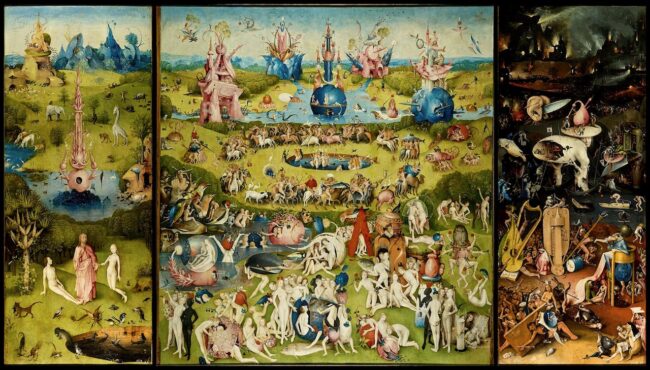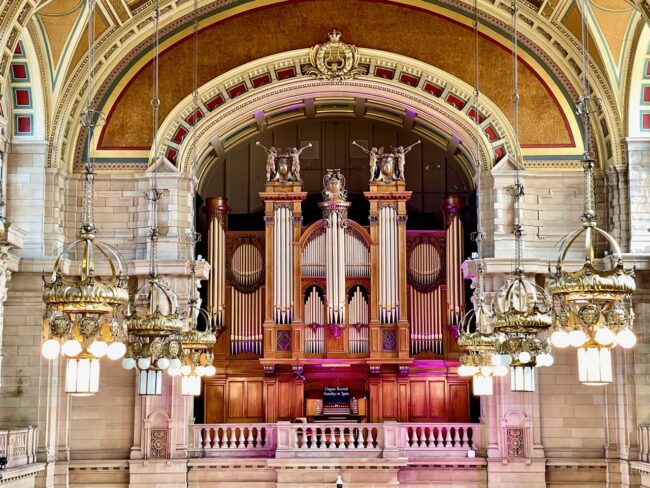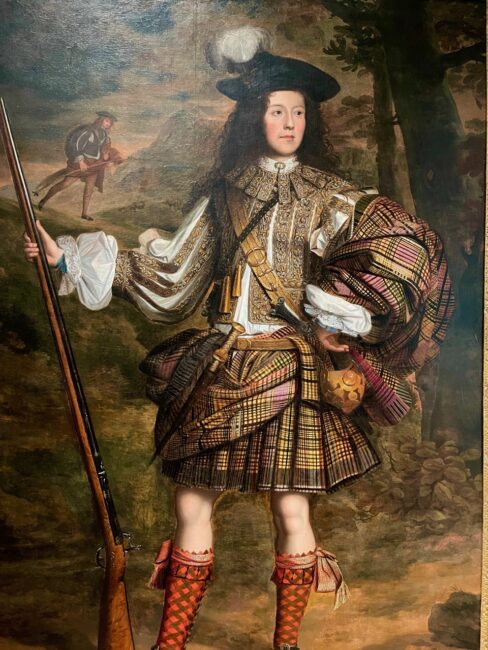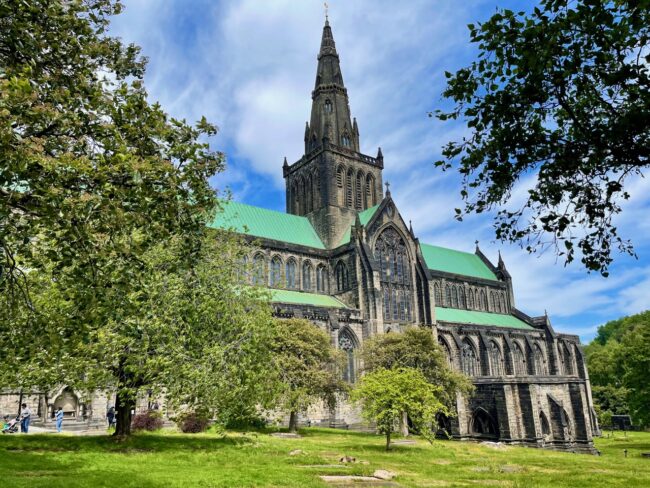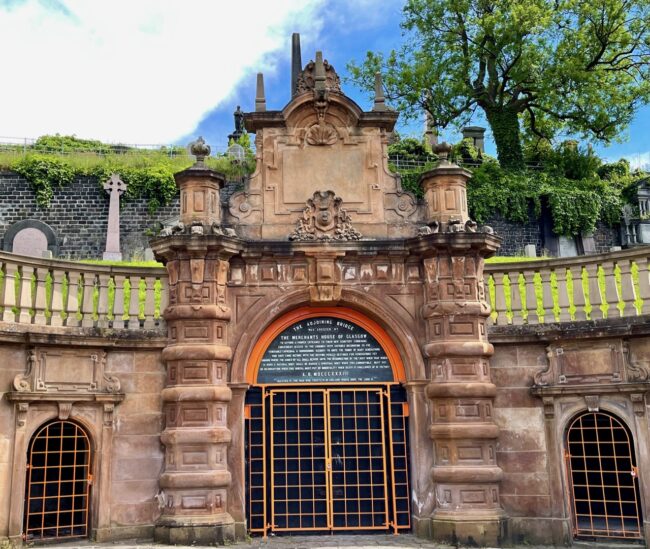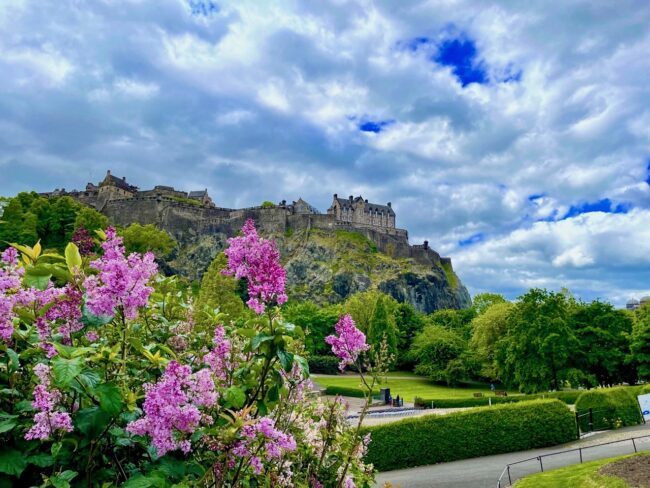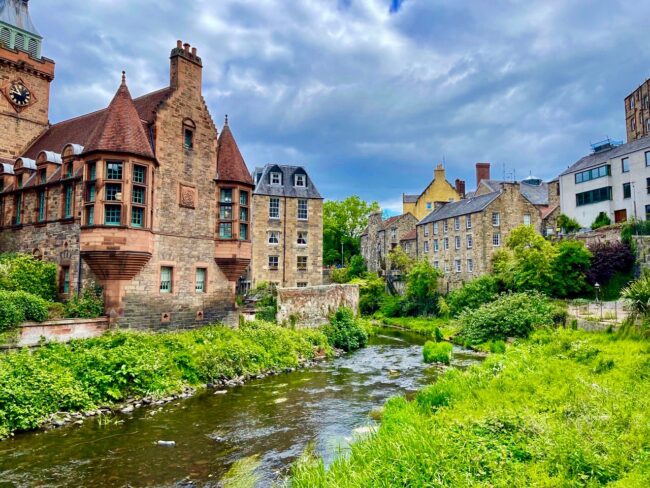
CHAPTER TWENTY: On To Glasgow
October 20, 2022Surviving Mai Tai Tom’s “Royal” Blunder: 2022 England & Scotland
CHAPTER TWENTY ONE: Glasgow … Art, History & Dead People
Days Twenty One & Twenty Two: The Most Visited Museum In The UK Outside London, Where Do They Land That Thing?, Elvis Has Not Left The Building, Heads Up, One Final Cathedral, Tombs With A View, Really Our Last Italian, Going Green and Is This Any Way To Test For Covid?
We awoke to a gorgeous, sunny morning. Once again we were fortunate to have a trip where the weather never really interfered with our plans. While Kim and Mary ate breakfast at the hotel, Tracy and I ventured into the neighborhood searching for coffee and pastries. As it turned out, a Smile could be found around the corner. Smile Cafe Glasgow (121 Douglas Street) is an Italian coffee shop and pizzeria. Being a little too early for pizza (well, it’s never really too early for pizza), Tracy and I had a delicious pastry and a cappuccino.
Back at the hotel, we grabbed Kim and Mary and Ubered to our first stop of the morning, Kelvingrove Art Gallery and Museum facing Kelvingrove Park, and purported to be the most visited museum outside of London in the UK. It is also the most popular free-to-enter visitor attraction in Scotland. It was a Sunday, and I missed one important detail … it didn’t open until 11 a.m. 
Since it was 10:30 we did what most people would do, go across the street and grab some extra pastries and cappuccinos at the very cute Ronzio Coffeehouse (1361 Argyle Street). Thankfully, with all our walking, we never seem to gain weight on our vacations. If we ate like this at home we’d be as big as an elephant. Coincidentally, in just a few minutes we’d see one.
At 11 a.m. sharp, the doors to the Kelvingrove swung open to visitors. The museum opened in 1901 and contains 22 galleries. In 2003 it was closed for three years for refurbishment and they did quite a job. The first aspect of the interior that struck us (not literally) was the beautiful architecture.
The center main hall is 125 feet long and 65 feet wide, and you could tell this art gallery and museum would hold a number of different pieces of interest from art to animal creatures to what seemed like everything in between as we meandered some its 22 galleries. One of the first unique things we saw in the main hall was a pachyderm with an airplane hovering over it. Tracy jokingly asked, “I wonder where that plane lands?” I replied, “Well, that’s certainly the elephant in the room.” The crew was glad we only had a day left on the trip. This large stuffed elephant is named Sir Roger. Sir Roger spent the 1890s with a traveling circus before retiring in 1900. It didn’t end well for him. At the zoo where he resided, due to a hormonal disorder he became very aggressive (which is why elephants really shouldn’t be in zoos). Sadly, one morning Sir Roger was shot and has lived (metaphorically) at the Kelvingrove since 1901.
The plane suspended from the ceiling above him is a Mark F21 Spitfire, developed in 1944 near the end of World War II. This plane flew with the City of Glasgow Auxiliary Squadron between 1947 and 1949. Like Sir Roger, things didn’t end well for this aircraft. It crash landed in 1949, but has been spectacularly restored, and it and Sir Roger co-exist peacefully in Kelvingrove’s main hall.
Something else you can’t miss in the Centre Hall is the Kelvingrove Organ, a gigantic concert pipe organ. It has 2,889 organ pipes, and I took their word for it. A mainstay at the Kelvingrove since 1901, it’s said that this organ holds the world record for being played at more daily recitals than any other organ.
In 1901, it was commissioned as part of the Glasgow International Festival and eventually moved here. The organ recital music varies, and for just a second I daydreamed I heard my favorite made-up Barcelona/Iron Butterfly rock tune, “In Sagrada Familia, Baby!” Alas, it was only a pipe (organ) dream.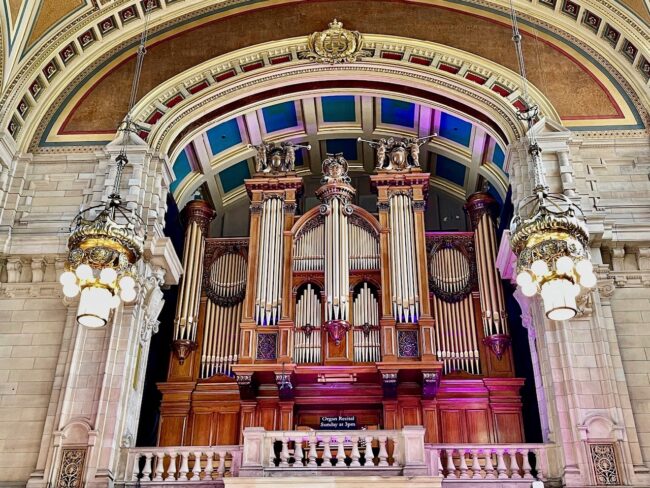
We took in a few of the 8,000 objects in the museum. I assumed the below belonged to King Charles when he was Duke of Edinburgh. Either him or John Wayne.
This piece was a shoe-in for weirdest “piece of art” we saw in the Centre Hall. I’m surprised it didn’t get the boot.
After someone flipped me the bird …
… we headed toward the first gallery (more on those heads later).
Looking for some of Kelvingrove’s paintings and sculptures, we entered the aptly named Looking For Art Gallery. One of my favorite artists is the Dutch master of crazy, Hieronymus Bosch (yes, I’m a little crazy, too). In this room was a Bosch imitator’s 16th-century painting of Christ Driving The Traders From The Temple.
We had seen my favorite Bosch painting, The Garden of Earthly Delights, at the Prado in Madrid back in 2015. The Kelvingrove painting is described as a “pastiche of Boschian elements.” (Garden Of Earthly Delights photo from internet … The Prado frowns on photos from its patrons.)
Did you ever accidentally break any of your mom’s China? Anthony Green did, so he crafted an unusual painting of what he remembered. Obviously, he had a China Syndrome,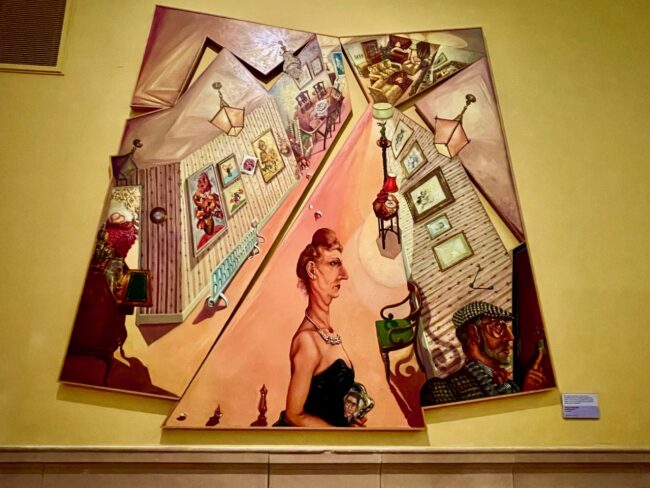
As a nearby sign stated, “Barcelona has Antoni Gaudi, Chicago has Frank Lloyd Wright and in Glasgow we have Charles Rennie Mackintosh,” all “giants of Art Nouveau architecture and design.” We saw a couple of his unique furniture creations.
In the 1920s and 1930s, engineer James Anderson designed four experimental cars dubbed “Anderson Specials.” In 1938 he built The Bug, which could go 85 mph. After seeing this fast car, we moved on at a much more accelerated pace.
A 19th century group of modern artists were nicknamed The Glasgow Boys, and some of their works can be found here. Harrington Mann was one of them.
Although not a Glasgow Boy, John Lavery liked to hang out with them and painted this picture of the principal artist of the Imperial Russian Ballet Anna Pavlova in 1910.
In 1997, Saint Elvis – Return To Sender was purchased. Where it came from remains a mystery, presumably because its address was unknown.
You get another great view of the Kelvingrove Organ from this viewpoint one floor up.
The Spitfire also looks different from up here. There were 602 pilots in the part-time squadron that flew these type planes in World War II. The plane looks like it’s flying right toward us, so I have to give props to Tracy for taking this photo.
From our vantage point on this floor we got a great view of The Floating Heads, a work of a woman named Sophie Cave. I would say that the installation turned heads when it opened, but I won’t.
Let’s face it, these 50 heads, alternating between maniacal, menacing, sad and comical, can bring out a lot of emotions from those who look. Some people love it. Others think it’s creepy. I guess opinions depend upon the eyes of the beholder.
We ducked into another gallery and said “Hello Dali” and his both admired and criticized painting Christ of St. John of the Cross. Dali was known for his Surrealist style of art, and this painting was quite a digression from his usual paintings as religion was not usually a part of his repertoire.
The Coronation of the Blessed Virgin is the 1923 work of Irish Arts and Crafts designer Harry Clarke. It was commissioned by a Glasgow chapel to mark its 25th anniversary, and also for those who perished in World War I.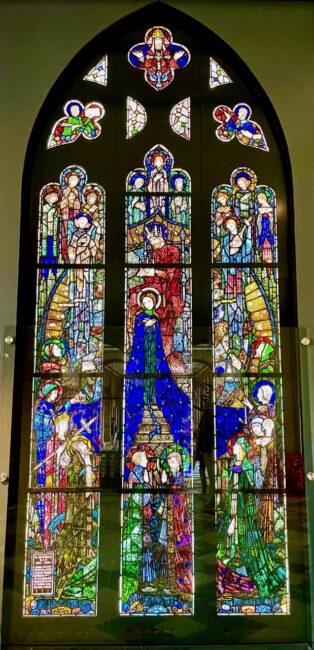
There’s also Rembrandt’s A Man In Armour, considered to be the “greatest of Glasgow’s Dutch Old Master paintings.” This mid-15th century painting might be of Alexander The Great … or not.
I didn’t get to hear the Kelvingrove Organ play Iron Butterfly, but did get to see Rachel Ruysch, the daughter of botany professor, and her painting that features, among other things, butterflies.
We gazed at GreyDay, Paris Plage, a 1905 painting by JD Fergusson, who people think was influenced by Monet. Not to be outdone, nearby was Monet’s 1880 Vétheuil, which only took the impressionist a few hours to complete.
The detail and colors of these two paintings were impressive.
Sam Bough’s 1876 painting of the cottage where Robert Burns was born was next. On the right is a portrait of Glasgow art dealer Alex Reid, who shared a flat with Vincent Van Gogh in 1887, so he posed for the famed artist.
We didn’t make it to Balmoral on this trip, but we did see a painting of the castle that Queen Victoria bought in 1848.
The final painting we saw is a cautionary tale of a young woman marrying an old man for his money. A sign next to it read, “… Why did I marry a man old enough to be my senior?”
Back in the hallway was a statue of a man who looked like actor John Forsythe. I wondered if the sculpture was named Bachelor Father (you have to be really old to know that one)?
There was still much more to see, but thanks to me not remembering Kelvingrove’s later Sunday opening time, we had to leave. I had allotted three hours to visit the museum, but we had to leave after two hours because we had timed tickets for another Glasgow attraction at 1:30. Needless to say, we were very much impressed with the Kelvingrove Art Gallery and Museum.
Also impressive was the last cathedral we visited on this trip. Constructed between 1136 and 1484 it is “Scotland’s largest place of worship.” It was built on on the site of St. Kentigern’s (aka St. Mungo) tomb and marks the birthplace of Glasgow. It’s also the oldest cathedral in mainland Scotland and the oldest building in Glasgow.
Glasgow Cathedral is the only Scottish mainland cathedral to survive the 1560 Reformation. Mungo was the founder and patron saint of the city of Glasgow and should not be confused with Mungo Jerry, who sang In The Summertime.
Although admittance is free, we did need to get a reservation time online before we visited. The stone arches, wood ceiling and stained glass windows were dazzling.
The choir ceiling was just as beautiful.
The attention to detail on all the cathedrals we visited (according to Kim we visited about 700 of them) on this trip was magnificent.
We headed down to the lower church where The Shrine To St. Mungo that dates from the 13th century is located.
It was constructed to house his tomb.
His is not the only tomb or burial site in the church.
We learned that Glasgow Cathedral doubled as L’Hôpital des Anges in the Outlander series.
We spent about an hour in the cathedral …
.. and it was nice way to finish our UK Cathedral Tour.
It was a short walk by the cathedral and up a hill to our next stop.
The Glasgow Necropolis is adjacent to Glasgow Cathedral. The Necropolis was modeled after Père-Lachaise in Paris, which we had visited ten years previously.
It’s said that 50,000 burials have taken place here and it contains about 3,500 tombs.
I walked around to choose mine.
We passed by the memorial to the author of Wee Willie Winkie, William Miller. By the time of his death, Miller was destitute, but this memorial was erected in his honor. I had the urge to run through the town in my nightgown for some reason.
These were all tombs with a view.
It was now a little past mid-afternoon, we were all wondering if we’d be in tomb if we didn’t have lunch. The two pastries and cappuccinos were now ancient history.
We walked back past Barony Hall, which was first used as a church. It’s now a ceremonial hall and events venue.
A mural on the side of a building with a man holding a small bird in his hand caught our eyes. It was created by an Australian street artist known as Smug and supposedly depicts St. Mungo in modern day clothes. According to legend, “when he (Mungo) was young, some boys from his village started throwing stones at robins that were pecking on the ground for scraps.
“One bird was hit and fell to the ground. The boys ran away. Mungo ran, too, but he ran to the fallen bird. Picking it up he smoothed and caressed its feathers and prayed over it. After a little while it revived and flew away. Perhaps it was only stunned. The villagers called it a miracle and so it was that a small boy should want to help a fallen bird in trouble.”
Soon we found ourselves back at the Italian Kitchen where we had dined the previous evening. Being equal-opportunity Italian food eaters, we crossed the street to Santa Lucia, where there was an open table outside. I had one of the greatest gorgonzola gnocchis here, and, as you can see, we didn’t worry about having enough pepper.
We headed back to the Dakota for a little R&R. Once again passing by the modern art museum, Tracy said she did want to take one photo. You can never get enough of ceiling shots.
Since we had eaten a late lunch, we shared a burger at Jacks’s in the Dakota for dinner. We needed to get our rest, because we would spend some time tomorrow morning taking our Facetime Covid tests (you still needed to test negative to return to the US at that time). The word ridiculous comes to mind about that little exercise.
FINAL DAY: On our last day in Glasgow, we had breakfast at Smile Cafe, and then walked down to Buchanan Street and the Hotel Chocolat to pick up some chocolate to take back to the assistants at the vet’s office where our cat was spending his vacation. We had wanted to test early, but when we tried to log on it had to be exactly 24 hours or less from your departure to the states to take the test.
We used an app called Navica and soon Tracy was Face Timing with a person. Tracy scanned the bar code for the test, swabbed and when the 15 minutes was up, someone came back online and asked her if there was one line or two. She said one, meaning she was negative. The person she was Face Timing with never even checked to see if she was telling the truth. When she got the email confirmation of a negative test result, they had input the wrong time on her test results which was outside the 24 hour limit. They had forgotten that we were in Scotland and put the U.S. time instead.
Then I tested. Same thing. They asked about whether I had tested positive. I said I had not, and voila, I was home free. Should I actually had a deathly bout of Covid, I still could have said I didn’t, and they would have let me go.
We went down to the hotel desk to print out the letter proving we were cleared to return to the US. When we told the woman at the desk our testing story she said, “I’m not surprised. Everyone is done with Covid.”
We found out how correct she was the following morning. When we checked in at British Airways, the ticket agent asked if we had our Covid-negative proof, and Tracy whipped out the letter and handed it to the guy who kept his head down. He gave the paper back to her without even glancing at it. We could have handed him a Barefoot Contessa recipe, and we still could have flown. Two days later this all became moot when President Biden relaxed the policy.
Following our tests, the four of negative tourists Ubered to the People’s Palace set in Glasgow Green. We had wanted to go to The Hunterian Art Gallery, but since I had no idea that today was Monday and it was closed, that did not become a reality. You know a vacation is nearing its end when you don’t even know the day of the week.
In front of the Glasgow Green, a museum that tells the history of Glasgow, stands the Doulton Fountain. This fountain became the most popular attraction at the 1888 International Exposition. It is constructed of red terra-cotta bricks and is the largest terra-cotta fountain in the world.
At one time, the Winter Gardens were located next door, but they have fallen into disrepair.
The museum was mildly interesting …
… but by now all we wanted to do was pack and be beamed back home. We did learn about the Glasgow Dogs …
… and the Bell from the Dike Street Prison, which rung when executed prisoners were declared dead. Each prisoner was hanged exactly at 8 a.m. 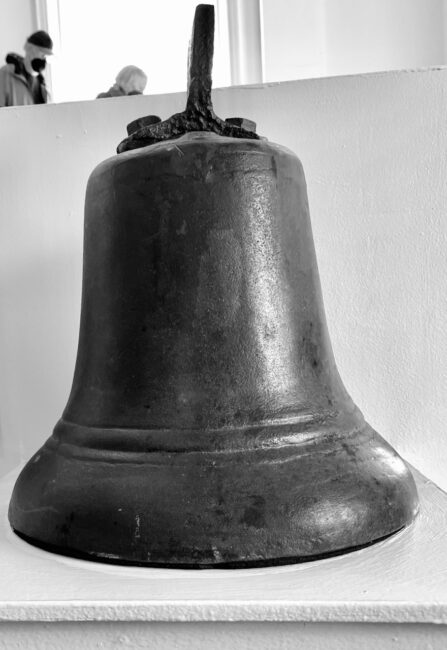
We learned that at one time in Glasgow, there were more than 200 crimes that could result in being hanged. Between 1814 and 1865, 67 men and 5 women were hanged, and they have the list to prove it.
Deciding that we had hung around here long enough, a sign on the museum wall gave us an idea. We walked to the nearby WEST on the Green Beer Hall & Garden where some Glasgow dogs need to be on their best behavior.
It was a cool place to enjoy a beer on our final afternoon.
The next morning we headed back to L.A. via Heathrow, while Kim and Mary flew to Dublin for a week with family. Fortunately, we passed through Heathrow the day before chaos became the norm at that airport, while Kim and Mary said the Dublin airport was a zoo.
EPILOGUE:
It had been quite a whirlwind three weeks. Starting in London …
… then on to my near encounter with Princess Anne in York and the York Minster …
… a quick stopover in Durham via Fountains Abbey …
… the lovely Northumberland area including Hadrian’s Wall and Holy Island …
… the Scottish Borders …
… Edinburgh …
… the spectacular scenery from Edinburgh to Oban …
… and the same from Oban to Inveraray …
.. and finally Glasgow.
We did get shut out of a number of places I had hoped to visit, but in all, we saw a number of gorgeous … and unusual … sights.
All the while (with a helpful nudge from Mary), we stuck to our motto:
Enjoy The Journey!
Attitude Is Everything!





